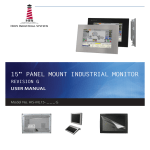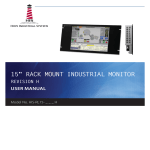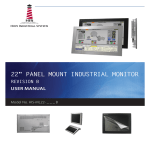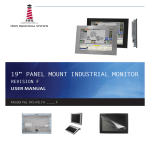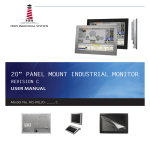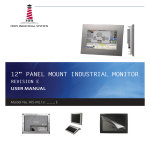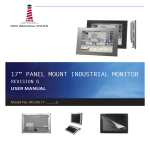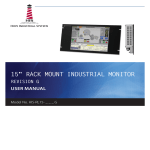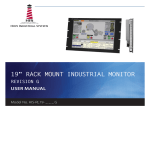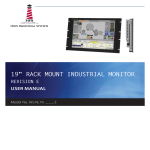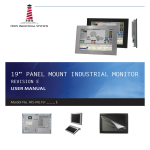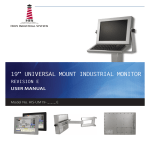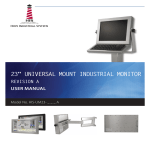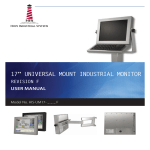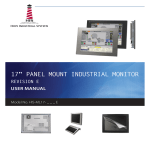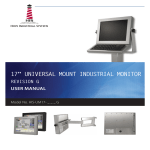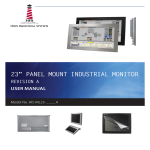Download User Manual - Hope Industrial Systems
Transcript
20" PANEL MOUNT INDUSTRIAL MONITOR REVISION A USER MANUAL Model No. HIS-ML20- _ _ _ A Table of Contents Safety and Regulatory Information��������������������������������������������������������������������������������3 FCC Notice����������������������������������������������������������������������������������������������������������������������������� 3 Waste Electrical and Electronic Equipment Directive (WEEE)����������������������������������������������� 4 Mechanical Drawings������������������������������������������������������������������������������������������������������5 Front and Side Views�������������������������������������������������������������������������������������������������������������� 5 Bottom View���������������������������������������������������������������������������������������������������������������������������� 5 Installation Instructions��������������������������������������������������������������������������������������������������6 Step 1: Prepare for Installation���������������������������������������������������������������������������������������������� 6 Step 2: Bench-test Configuration������������������������������������������������������������������������������������������� 7 Install Cable Connections������������������������������������������������������������������������������������������������������������������ 7 Install Touch Screen Driver���������������������������������������������������������������������������������������������������������������� 8 Step 3: Install into Panel������������������������������������������������������������������������������������������������������ 10 Video Settings����������������������������������������������������������������������������������������������������������������12 Setting the Timing Mode������������������������������������������������������������������������������������������������������� 12 Control Panel Buttons����������������������������������������������������������������������������������������������������������� 13 OSD and Power Lock Settings��������������������������������������������������������������������������������������������� 14 On-Screen Display (OSD) Menus����������������������������������������������������������������������������������������� 15 Picture Menu������������������������������������������������������������������������������������������������������������������������������������ 15 Color Menu�������������������������������������������������������������������������������������������������������������������������������������� 16 Position Menu���������������������������������������������������������������������������������������������������������������������������������� 16 Tracking Menu��������������������������������������������������������������������������������������������������������������������������������� 17 Setup Menu�������������������������������������������������������������������������������������������������������������������������������������� 18 Image Presets Menu������������������������������������������������������������������������������������������������������������������������ 19 Cleaning Instructions����������������������������������������������������������������������������������������������������20 Troubleshooting������������������������������������������������������������������������������������������������������������21 Video Troubleshooting���������������������������������������������������������������������������������������������������������� 21 Touch Screen Troubleshooting��������������������������������������������������������������������������������������������� 23 Specifications����������������������������������������������������������������������������������������������������������������24 Display���������������������������������������������������������������������������������������������������������������������������������� 24 Electrical������������������������������������������������������������������������������������������������������������������������������� 24 Environmental����������������������������������������������������������������������������������������������������������������������� 24 Video������������������������������������������������������������������������������������������������������������������������������������� 25 Functional����������������������������������������������������������������������������������������������������������������������������� 25 Physical�������������������������������������������������������������������������������������������������������������������������������� 26 Compliances and Certifications�������������������������������������������������������������������������������������������� 26 Warranty Statement�������������������������������������������������������������������������������������������������������27 2 ML20A User Manual, August 2013 Safety and Regulatory Information Safety and Regulatory Information ! WARNING! To prevent fire or shock hazard, do not expose live components to rain or moisture. Dangerously high voltages are present inside the unit. Do not disassemble the unit. Refer servicing to qualified personnel only. This equipment is not intended for use in critical applications where its failure to operate would create immediate life threatening circumstances. Applications including, but not limited to, nuclear reactor control, aerospace navigation systems and life support systems are not appropriate for this product. This product is intended to be mounted in a suitable cabinet or other enclosure. The NEMA 4, 4X, or 12 ratings are applicable only when properly installed in a like rated enclosure. To be covered by UL 60950 3rd Edition, the socket-outlet shall be installed near the equipment and shall be easily accessible. FCC Notice This equipment has been tested and found to comply with the limits for a Class A digital device, pursuant to Part 15 of the FCC Rules. These limits are designed to provide reasonable protection against harmful interference when the equipment is operated in a commercial environment. This equipment generates, uses, and can radiate radio frequency energy and, if not installed and used in accordance with the instruction manual, may cause harmful interference to radio communications. Operation of this equipment in a residential area is likely to cause harmful interference in which case the user will be required to correct the interference at his own expense. Any changes or modifications not expressly approved by the grantee of this device could void the user’s authority to operate the device. ML20A User Manual, August 2013 3 Safety and Regulatory Information Waste Electrical and Electronic Equipment Directive (WEEE) The following information is only for EU-member states: The mark shown to the right is in compliance with the Waste Electrical and Electronic Equipment Directive 2002/96/EC (WEEE). The mark indicates the requirement NOT to dispose of the equipment as unsorted municipal waste, but use the return and collection systems according to local law. Users should contact their supplier and check the terms and conditions of the purchase contract. When purchased directly from Hope Industrial Systems, you may contact technical support for disposal arrangements. 4 ML20A User Manual, August 2013 Mechanical Drawings Mechanical Drawings Front and Side Views 482.6 mm (19.00") 337.6 mm (13.29") 307.6 mm (12.11") 398.8 mm (15.70") 409.2 mm (16.11") 7.1 mm (0.28") Bottom View 453.4 mm (16.97") 7.1 mm (0.28") 67.8 mm (2.67") (Design to maximum depth of 74.0 mm to ensure future compatibility with later revisions and replacement units.) 482.6 mm (19.00") ML20A User Manual, August 2013 5 Installation Instructions Installation Instructions Step 1: Prepare for Installation IMPORTANT! Perform the following steps BEFORE installation of the monitor into the panel. 1. Ensure that sufficient power is available. 2. Ensure that sufficient space is available to allow for proper air flow into and out of the unit. 3. Ensure that the air temperature around the unit (top and bottom) will not exceed the rated specifications of the unit. ! ff The maximum rated temperature for the HIS-ML20 is 50°C (122°F). ff Remember that heat rises – the temperature at the top of the cabinet will be much hotter than at the bottom if air inside the enclosure is not actively circulating. Even in a sealed enclosure, use of a circulation fan can greatly reduce temperature. ff Also, remember that even though this product is designed to operate at 50°C, the life span of any electronic device is shortened when it is consistently operated at high temperatures. Therefore, it is wise to take steps to keep the temperature of the ambient air around the unit as low as possible. 4. Ensure that the ambient humidity of the air around the unit does not exceed the specifications of the unit. ff The maximum rated humidity for the HIS-ML20 is 90% non-condensing. 6 ML20A User Manual, August 2013 Installation Instructions Step 2: Bench-test Configuration Make sure everything works before installing into the production environment. TIP! If using a KVM extender, please refer to the installation instructions included with the KVM extender module. It is particularly important to bench-test the full configuration prior to final installation. This will help to identify and troubleshoot any system issues while configuration changes may still be easily made. Install Cable Connections All monitors are shipped with both a 6 ft. VGA video cable and 6 ft. power cable, unless longer cables were ordered in their place. If you ordered a touch screen monitor, you also received a 6 ft. Serial (RS-232) cable and 6 ft. USB cable. The cable ports are located on the rear of the monitor. Refer to the following diagram and instructions to connect power, video, and touch screen (if applicable) to your monitor. POWER INPUT DIGITAL VIDEO SERIAL (RS-232) USB (for Touch Screen option) ANALOG VIDEO Video Connection The HIS-ML20 supports analog and digital video. Analog Video Connection Connect one end of the VGA video cable to the HD-15 input port on the rear of the monitor. Connect the other end to the analog video output port on the host computer. ML20A User Manual, August 2013 7 Installation Instructions Digital Video Connection Connect one end of the DVI video cable to the DVI-D input port on the rear of the monitor. Connect the other end to the digital video output port on the host computer. Power Connection The HIS-ML20 is powered by 100 to 240 VAC, 0.8/0.4 A, 60/50 Hz. Connect the AC power cable to the power input port on the rear of the monitor. Connect the other end into a nearby outlet. Install Touch Screen Driver Applies to touch screen monitors only. Instructions below apply to Windows systems. Both Serial and USB ports are present on all touch screen monitors, but only one should be used to connect the touch screen interface to the monitor. All touch screen monitors are shipped with a CD-ROM that contains documentation and drivers for all major operating systems. To be sure that you have the most current information, please check the following Internet address: http://www.HopeIndustrial.com/Touchscreen_Drivers.htm IMPORTANT! If you will be using a Serial connection, connect the Serial cable first, and then install the touch screen driver. If you will be using a USB connection, install the touch screen driver first, and then connect the USB cable. Serial (RS-232) Connection 1. Connect one end of the Serial cable to the Serial input port on the rear of the monitor. Connect the other end to the Serial port on the host computer. Tighten the captive screws on the cable connectors to ensure adequate strain relief. 8 ML20A User Manual, August 2013 Installation Instructions 2. Select the appropriate driver for your operating system. a. If downloading from the web address listed above, select the appropriate driver for your operating system. b. If using the included CD, insert it into the host computer's CD-ROM drive. If the CD does not automatically run, browse the contents of the CD and open the READ.ME.FIRST.htm file in a web browser. Select the appropriate driver. NOTE: For Windows 7 and Vista operating systems, you must save the driver to a location on your hard drive, then run using elevated privileges by right-clicking on the file and selecting "Run as administrator". 3. Click to "Run" the software when prompted. Follow on-screen instructions to download and execute the touch screen driver installation. USB Connection 1. Select the appropriate driver for your operating system. a. If downloading from the web address listed above, select the appropriate driver for your operating system. b. If using the included CD, insert it into the host computer's CD-ROM drive. If the CD does not automatically run, browse the contents of the CD and open the READ.ME.FIRST.htm file in a web browser. Select the appropriate driver. NOTE: For Windows 7 and Vista operating systems, you must save the driver to a location on your hard drive, then run using elevated privileges by right-clicking on the file and selecting "Run as administrator". 2. Click to "Run" the software when prompted. Follow on-screen instructions to download and execute the touch screen driver installation. 3. A cable retention bracket comes installed on the USB port on the rear of the monitor and will help to secure the cable and ensure adequate strain relief. Route one end of the USB cable through the retention bracket and connect it to the USB input port on the monitor. Connect the other end to the USB port on the host computer. Calibrate the Touch Screen Once the driver has finished installing, you are ready to calibrate the touch screen. Open the touch screen's Control Panel by clicking on the "Elo Touchscreen" icon, located in the host computer's Control Panel. Under the "General" tab, click the "Align" button to start the calibration routine. ML20A User Manual, August 2013 9 Installation Instructions Step 3: Install into Panel Once you have completed the full bench-test configuration and confirmed that all components are working properly, you are ready to install the monitor into its panel cutout. ! WARNING! Hope Industrial Systems will not assume liability for damage to internal electronics due to improper installation. Contact Hope Industrial Systems if you need additional assistance. 1. Refer to the drawing below for the cutout dimensions for the HIS-ML20. 453.4 mm (17.85") 366.8 mm (14.44") 2. Locate position in panel for mounting of the monitor. Ensure that there is adequate space behind the panel. Allow extra space – 25.4 mm (1.0") behind and on each side – for air ventilation. 10 ML20A User Manual, August 2013 Installation Instructions 3. Cut a rectangular hole in the panel. ff Cutout Dimensions (W x H) for the HIS-ML20: 453.4 mm x 366.8 mm (17.85" x 14.44"); ± 0.5 mm (0.020") 4. Clean and deburr the panel hole. 5. Separate the rear collar from the monitor by removing the 12 nuts. 6. Refer to the enclosure mounting diagram below. 7. Insert the unit into the front of the panel and re-attach the collar. NOTE: Contact Hope Industrial Systems if for any reason your application does not allow for installation of the collar. 8. Tighten all 12 nuts to a torque of 10-15 inch-pounds to ensure a watertight seal between the bezel gasket on the monitor and the equipment panel. Go around all nuts twice to ensure an even compression on gasket. NOTE: If a torque wrench is not available, tighten all nuts evenly until bezel sits 1.6 to 2.4 mm (1/16" to 3/32") off the front of the panel. ML20A User Manual, August 2013 11 Video Settings Video Settings Setting the Timing Mode Setting the timing mode of your computer graphics adapter (or other video source) is important for maximizing the quality of the screen image and for minimizing eye strain. The timing mode consists of the resolution (e.g. 1600 x 1200) and refresh rate (or vertical frequency; e.g. 60 Hz). After setting the timing mode, use the On-Screen Display (OSD) controls to adjust the screen image. TIP! For the best picture quality, set your computer graphics adapter timing mode to: VESA 1600 x 1200 @ 60 Hz Please refer to the computer graphics adapter manufacturer's manual for instructions on setting the resolution and timing mode. In Microsoft Windows, these settings may be found at the following location: ff 2000, XP: Control Panel > Display > Settings ff Vista: Control Panel > Personalization > Display Settings ff Windows 7: Control Panel > Appearance and Personalization > Adjust Screen Resolution 12 ML20A User Manual, August 2013 Video Settings Control Panel Buttons Use the control panel buttons located on the back of the monitor to display and adjust various settings on the On-Screen Display (OSD) menu. CONTROL PANEL BUTTONS 1. To display the Main Menu, press the Menu button. NOTE: All OSD menus and adjustments screens disappear automatically after 20 seconds. 2. To select a control to adjust, press the minus [ – ] or plus [ + ] button to scroll through the menu. 3. Press the Auto/Set button to open the menu for a selected control. 4. To adjust the control, press the minus [ – ] or plus [ + ] button. Press the Auto/Set button to scroll to the next control. 5. To save the adjustments and return to the main OSD menu, press the Menu button once. To exit the OSD menu, press the Menu button twice. ML20A User Manual, August 2013 13 Video Settings Button Control Functions Menu • Opens the OSD menu. • Exits the OSD menu and saves adjustments. Minus / Image Presets Menu When the OSD menu IS NOT displayed: • Shortcut to Image Presets menu. When the OSD menu IS displayed: • Scrolls down and adjusts items in the menu down. Plus / Input Source When the OSD menu IS NOT displayed: • Toggles between the D-Sub and DVI input connectors. The default setting is D-Sub. When the OSD menu IS displayed: • Scrolls up and adjusts items in the menu up. Auto / Set When the OSD menu IS NOT displayed: • Shortcut to Auto Image Adjust. When the OSD menu IS displayed: • Displays the control screen for the highlighted control. • Saves adjustments made in control menus and scrolls down to the next control. Power Turns the monitor on and off. Power Indicator Light • LED lit blue – power is ON • LED not lit – power is OFF • LED lit orange – monitor is in Energy Saving mode OSD and Power Lock Settings ff OSD Lock: Press and hold the Menu button for 5 seconds. The message OSD Locked should appear. If any buttons are pressed the message OSD Locked will display. ff OSD Unlock: Press and hold the Menu button again for 5 seconds. The message OSD Unlocked should appear. 14 ML20A User Manual, August 2013 Video Settings On-Screen Display (OSD) Menus To open the OSD menu, press the Menu button once. Main Menu Description Picture Includes the Brightness, Contrast, and Gamma functions. Color Provides several color adjustment modes. Position Includes the Horizontal and Vertical position functions. Tracking Includes the Clock, Phase, and Sharpness functions. Setup Includes the Language, OSD Position, White Balance, Power Indicator, and Factory Reset functions. Image Presets Provides several adjustment settings for optimizing the image. Picture Menu The Picture menu includes the Brightness, Contrast, and Gamma functions. PICTURE Picture Menu Description Brightness Adjusts the background black level of the screen image. Contrast Adjusts the difference between the background (black level) and the foreground (white level) of the screen image. Gamma Adjusts the gamma value. High gamma values display whitish images and low gamma values display high contrast images. ML20A User Manual, August 2013 15 Video Settings Color Menu The Color menu provides several color adjustment modes, including preset color temperatures and individual adjustments for red, green, and blue. The factory setting for this product is 6500K. COLOR Color Menu Description Preset There are three preset color modes to choose from: • sRGB sets the screen color to fit the sRGB standard color specification. This is quickly becoming the industry standard for color management, with support being included in many of the latest applications. Enabling this setting allows the LCD to more accurately display colors the way they were originally intended. • 6500K adds red to the screen image for warmer white and richer red. • 9300K adds blue to the screen image for cooler white (used in most office settings with fluorescent lighting). Red / Green / Blue Individual color adjustments for red, green, and blue levels. Position Menu The Position menu includes the Horizontal and Vertical Position functions for adjusting the position of the screen image. POSITION 16 ML20A User Manual, August 2013 Video Settings Position Menu Description Horizontal Moves the screen image left and right. Vertical Moves the screen image up and down. Tracking Menu The Tracking menu includes the Clock, Phase, and Sharpness functions. TRACKING Tracking Menu Description Clock Adjusts the screen image for stability and clarity by minimizing any vertical bars or stripes visible on the screen background. NOTE: Adjusting the Clock setting will change the horizontal size of the screen image. Phase Adjusts the focus of the screen image. The Phase setting allows the user to remove any horizontal noise and sharpen the image of characters. Sharpness Adjusts the clarity of the screen image. ML20A User Manual, August 2013 17 Video Settings Setup Menu The Setup menu includes the Language, OSD Position, White Balance, Power Indicator, and Factory Reset functions. SETUP MENU SETUP - + SET MENU - + SET Setup Menu Description Language Allows the user to choose the language used in the menus and control screens. OSD Position Allows the user to adjust the position of the OSD menu. White Balance If the output of the video card is different from the required specifications, the color level may deteriorate due to video signal distortion. Enabling this setting adjusts the video signal level to fit into the standard output level of the video card in order to provide the optimal image. Activate the White Balance function when white and black colors are present in the screen. Power Indicator Allows the user to turn the Power Indicator light On or Off. Factory Reset Returns adjustments back to factory default settings. 18 ML20A User Manual, August 2013 Video Settings Image Presets Menu The Image Presets menu provides several adjustment settings for optimizing the image. This feature can only be accessed by pressing the minus [ – ] button outside of the OSD menu. NOTE: When you activate Image Presets, two tones will appear on the screen as shown in the image below. The applied (adjusted) screen will appear on the left side and the non-applied (nonadjusted) screen will appear on the right side. Press the Auto/Set button to apply the adjustments. Image Presets Menu Description Movie Optimizes the screen for animation images in videos or movies. Text Optimizes the screen for text images. User Allows the user to manually adjust Brightness, Adaptive Clarity Enhancer (ACE), and Real Color Management (RCM). • Brightness adjusts the brightness of the screen image. • ACE selects the clarity mode. • RCM selects the color mode. Four modes are available: 0 (Not Applied) 1 (Green Enhance) 2 (Flesh Tone) 3 (Color Enhance) NOTE: Adjusted values can be saved or restored even when using a different environment setting. Select the SAVE function using the Auto/Set button then select YES. Normal Optimizes the screen for normal operating conditions. ML20A User Manual, August 2013 19 Cleaning Instructions Cleaning Instructions ! CAUTION! DO NOT USE ABRASIVE MATERIALS, SUCH AS PAPER TOWELS OR DIRTY SHOP RAGS, ON THE DISPLAY AS IT WILL SCRATCH THE PROTECTIVE COATING. ALWAYS USE A SOFT CLOTH, PREFERABLY MADE OF COTTON. All displays may be cleaned using any standard glass cleaner as long as there is no abrasive or oily content. Vinegar or ammonia will not hurt the screen. The anti-reflective coatings on glass window-equipped displays are physically part of the surface of the glass and resist degradation to the Military Specifications. To minimize over-run of cleaning solution, spray the cloth first and then clean the screen. 20 ML20A User Manual, August 2013 Troubleshooting Troubleshooting Video Troubleshooting IMPORTANT! If using a KVM extender, first try to resolve any problems using the solutions listed below. If the problem still exists, try bypassing the KVM extender. If this fixes the problem and allows the monitor to work properly, then the KVM extender is the source of the problem. Please refer to the troubleshooting section of the KVM extender manual or contact Hope Industrial Systems for additional assistance. Symptom Causes Solutions No image on the screen and control's Power Indicator light is not lit Monitor is not powered on. • Press the Power button on the monitor and make sure the Power Indicator light is lit blue. "Check Signal Cable" message box and no image on the screen Video cable is not plugged in correctly. Check the video cable connection at the monitor, PC, and/or KVM extender. No image on the screen and control's Power Indicator light is lit orange PC is in Power Saving mode. Power Saving mode can usually be exited by moving the mouse or pressing a key on the keyboard. PC is not powered on. Ensure PC is powered on. PC is not sending signal. Connect the PC to another known working monitor to check the PC source signal. • Check power connections at the monitor and power source. ML20A User Manual, August 2013 21 Troubleshooting Symptom Causes Solutions "Out of Range" message box and no image on the screen The signal from the computer exceeds the maximum resolution and/or refresh rate that the monitor can handle ( > 1600 x 1200 resolution or > 85 Hz refresh rate). Adjust the computer settings to the monitor's native resolution: Incorrectly displayed or partial image on the screen Monitor has not been adjusted correctly for the source signal. • Press the Auto/Set button on the rear control panel of the monitor to activate the display's "Image Adjustment" function. 1600 x 1200 @ 60 Hz • Fine tune the picture by manually adjusting the image. Refer to the OSD Menus section in this manual. Wrong or abnormal colors (white is not white) Monitor color settings are incorrectly adjusted. Reset the monitor to the factory default settings. In the monitor's OSD menu, this function can be found in the "Setup" menu. Video cable is not securely connected. If any colors (red, green, or blue) are missing, check the video cable to make sure it is securely connected. Video cable is bad. Check to make sure there are no loose or broken pins in the cable connector. Shorts in the cable could also cause an improper image to display. Screen image is dim Brightness and/or contrast settings are not set properly. Adjust the monitor's brightness and contrast settings. In the monitor's OSD menu, these functions can be found in the "Picture" menu. The message "OSD Locked" appears when attempting to open the OSD menu The OSD has been locked to prevent unauthorized changes to display settings. Press and hold the Menu button for 5 seconds. The message "OSD Unlocked" should appear. 22 ML20A User Manual, August 2013 Troubleshooting Touch Screen Troubleshooting Applies to touch screen monitors only. To be sure that you have the most current driver, please check the following Internet address: http://www.HopeIndustrial.com/Touchscreen_Drivers.htm Symptom Causes Solutions No response when touching the touch screen Touch screen driver has not been installed. Download and install the latest driver from the Hope Industrial website. Touch screen cable is not plugged in correctly. Make sure either the USB or Serial cable is securely connected to the monitor and PC. Do not connect both. If using a USB connection, does the USB cable length exceed 3 meters? USB cables have a 3 meter limitation and could cause no touch response if this is exceeded. If using a Serial connection, is the Serial cable plugged into the correct COM port? Ensure that the Serial cable is connected to the COM port being used prior to installing the touch screen driver. Touch screen driver has not been installed. Download and install the latest driver from the Hope Industrial website. Touch screen has not been calibrated. Activate the calibration utility. In Windows systems, these settings may be found at the following location: The cursor moves but does not follow my finger when touching the touch screen Control Panel > Elo Touchscreen > "General" Tab • Press the Align button. • Touch all targets as the appear to calibrate the touch screen. • Press the Green Check button when verified. ML20A User Manual, August 2013 23 Specifications Specifications Display Type Thin-film transistor (TFT) Active Matrix Liquid Crystal Size 20" diagonal Image Size (W x H) 408 mm x 306 mm (16.06" x 12.05") Native Resolution UXGA (1600 x 1200, 4:3 aspect ratio) Minimum Resolution VGA (640 x 350) Pixel Pitch 0.255 mm x 0.255 mm Number of Colors 16.7 million Brightness (white) 300 nits (cd/m2) Viewing Angle (Hori/Vert) 178° / 178° Contrast Ratio (typical) 800:1 Backlight Six CCFTs (Cold Cathode Fluorescent Tube); 45,000 hour brightness half-life Electrical Monitor Input 100 to 240 VAC, 0.8/0.4 A, 60/50 Hz Power Consumption ~ 58 W Power Consumption (Standby mode) <2W Environmental Temperature 0° to 50°C (32° to 122°F) Humidity 20% to 90% non-condensing Operating Shock 15 g, 6 msec, half-sine Operating Vibration (sine) 1.0g, swept sine 9 – 500 Hz Transport Vibration (random) 0.1g2 / Hz, 10 – 200 Hz Altitude • Operating: up to 10,000 feet 0.03g2 / Hz, 200 – 2000 Hz • Non-operating: up to 40,000 feet 24 ML20A User Manual, August 2013 Specifications Video Input Connectors • HD-15, DVI-D • Optional BNC input using HD-15 to 5-wire BNC adapter; see "Input Signal Formats" for a list of compatible video signals. • Optional DisplayPort input using DisplayPort to VGA or DisplayPort to DVI adapter. Input Signal Formats • RGB Analog video, 0.7 Vp-p, 75 Ohms Compatible sync modes: Separate H/V sync, Combined sync, Sync on Green • DVI NOTE: NTSC/PAL composite input available (call for details) Horizontal Scan 28 – 83 kHz Vertical Scan 56 – 85 Hz Supported Video Standards • 1600 x 1200 @ 60 Hz • 1280 x 1024 @ 60, 75 Hz • 1152 x 900 @ 65 Hz • 1152 x 870 @ 75 Hz • 1024 x 768 @ 60, 75, 85 Hz • 832 x 624 @ 75 Hz • 800 x 600 @ 60, 75, 85 Hz • 720 x 400 @70 Hz • 640 x 480 @ 60, 75, 85 Hz • 640 x 350 @ 70 Hz Response Rate (typical) 8 ms Functional Control Panel Buttons Menu, – (Down / Image Presets Menu), + (Up / Input Source), Auto / Set, Power On-Screen Display (OSD) Menus Picture, Color, Position, Tracking, Setup, Image Presets Touch Screen Option 5-wire resistive system; emulates a mouse; Serial (RS-232) and USB interface to host computer ML20A User Manual, August 2013 25 Specifications Physical Enclosure Type Panel mount; rear collar compresses gasket against panel (5/16" maximum panel thickness); held by 12 M5 studs Panel Rating (with proper installation) Built to IP65/IP66 standards • NEMA/UL Type 12/4 (Black Powder-Coated Faceplate) • NEMA/UL Type 12/4/4X (Stainless Steel Faceplate) Depth • Total Product Depth – 67.8 mm (2.67") • Depth Behind Front Edge of Panel – 60.7 mm (2.39") NOTE: Design to maximum depth of 74.0 mm (67.0 mm behind front edge of panel) to ensure future compatibility with later revisions and replacement units. Front Bezel Outside Dimensions (W x H x D) 482.6 mm x 398.8 mm x 7.1 mm (19.0" x 15.7" x 0.28") (not including gasket) Cutout Dimensions (W x H) 453.4 mm x 366.8 mm (17.85" x 14.44"); ± 0.5 mm (0.020") Net Weight 22 lbs. Shipping Weight 25 lbs. Compliances and Certifications Electrical • UL 60950 3rd Edition / cUL Recognized Component (File No. E212889) • UL 508A Listed (File No. E318630) • FCC Class A • CAN ICES-3A/NMB-3A • CE Environmental • IEC 60721-3 (Reliability) • WEEE (Registration No. WEE/DJ1859ZX for UK only) Enclosure 26 UL 50E (File No. E318630) ML20A User Manual, August 2013 Warranty Statement Warranty Statement Who is Covered? This warranty covers the purchaser of this product only and is not transferable without our written consent. What Does This Warranty Cover and What is the Period of Coverage? We warrant this product to be free from defects in material and workmanship, subject to the conditions set forth below. The warranty on all industrial display products, KB-R2 and KB-M2 keyboard series, KVM2 extender series, and ENCL-TC01, ENCL-TC02, and ENCL-PC10 enclosure series remains in force for a three year period beginning on the date we invoice you. The warranty period on KB-PL1 keyboards is two years, and all other keyboards carry a one year warranty. If Hope Industrial Systems repairs or replaces a product under warranty, its warranty term is not extended. What Will We Do to Correct Problems and How Do You Get Service? We will repair or replace (at our sole option) any part of the unit which proves to be defective. Replacement parts may be new or refurbished and will meet the same specifications of the original parts or unit. For orders sold through our U.S. operations, we will return the product to you by the shipping method we choose in the U.S.A. at our expense. You must pay for shipments to locations outside of the U.S.A. For products originally sold through Hope Industrial U.K., return shipping to and from Hope Industrial repair facilities and any EU member country (except Malta and Cyprus) will be provided using a pre-paid UPS shipping label sent via email. In order to receive warranty service you must get prior approval from Hope Industrial Systems. To request warranty service you can telephone us at +1 678 762 9790 or +44 (0) 20 7193 2618 in the United Kingdom or send an email to [email protected]. If we determine that warranty service is needed we will give you a Return Material Authorization (RMA) number. This RMA number must be conspicuously marked on the outside of the shipping box. Hope Industrial Systems will not accept shipments not accompanied by the RMA number. Except where otherwise noted, you must ship or deliver the product to Hope Industrial Systems Freight prepaid. What Does This Warranty Not Cover? This warranty does not cover equipment which has been damaged due to misuse, abuse, or accident such as: operating the equipment outside of published specifications; exposure to chemicals or gases not covered by specified NEMA standards; displaying fixed images for long periods of time resulting in afterimage effects; improper or unauthorized repair by anyone other than Hope Industrial Systems or a service agency authorized by Hope Industrial Systems to perform such repairs; fire, flood, “acts of God”, or other contingencies beyond the control of Hope Industrial Systems. Hope Industrial Systems’ responsibility for malfunctions and defects in hardware is limited to repair and replacement as set forth in this warranty statement. Hope Industrial Systems shall not be liable for direct, indirect, incidental, consequential, or other types of damages resulting from the use of any Hope Industrial Systems product other than the liability stated above. These warranties are in lieu of all other warranties express or implied, including, but not limited to, the implied warranties of merchantability or fitness for a particular purpose. Some states do not allow the exclusion of implied warranties or the limitation or exclusion of liability for incidental or consequential damages so the above exclusions or limitations may not apply to you. You are cautioned that the performance of this product can be affected by many factors, such as system configuration, software, application, and operator control of the system. It is your responsibility to determine suitability of this product for your purpose and application. ML20A User Manual, August 2013 27 Hope Industrial Systems, Inc. US / International 1325 Northmeadow Parkway Suite 100 Roswell, GA 30076 United States Toll Free: (877) 762-9790 International: +1 (678) 762-9790 Fax: +1 (678) 762-9789 Sales and Customer Service: [email protected] Support and Returns: [email protected] Accounting Department: [email protected] www.HopeIndustrial.com UK Harling Road Snetterton Norwich NR16 2JU United Kingdom Phone: +44 (0) 20 7193 2618 Fax: +44 (0) 20 7117 1194 Sales and Customer Service: [email protected] Support and Returns: [email protected] Accounting Department: [email protected] www.HopeIndustrial.co.uk 28 ML20A User Manual, August 2013 © 2013 Hope Industrial Systems, Inc.




























